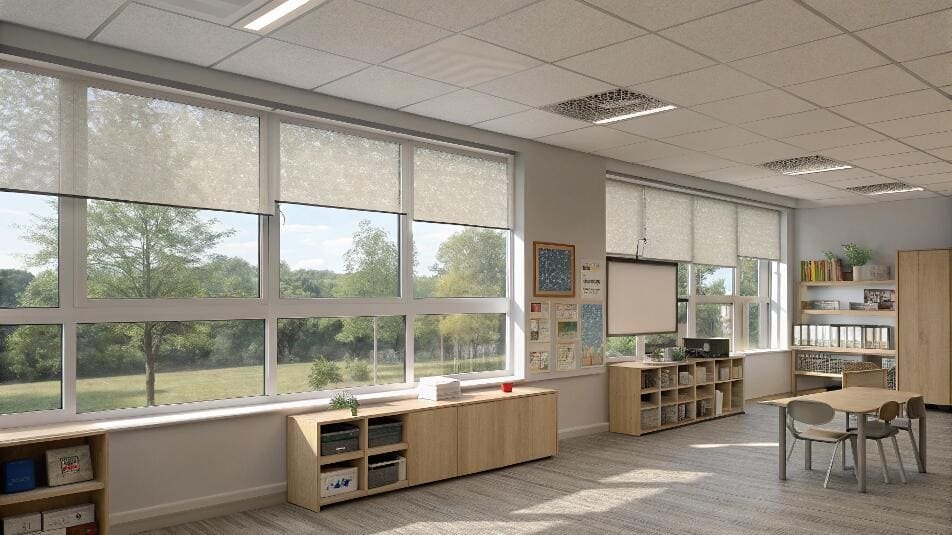Are you tired of specifying separate sheer and blackout blinds for your projects? This approach is often costly, clutters the window frame, and creates a headache for daily operation.
A dual blind system is the definitive answer. It integrates two distinct fabrics—typically a solar screen and a blackout shade—into a single, sleek headrail. This provides unmatched versatility for controlling light, glare, and privacy with one efficient window treatment.
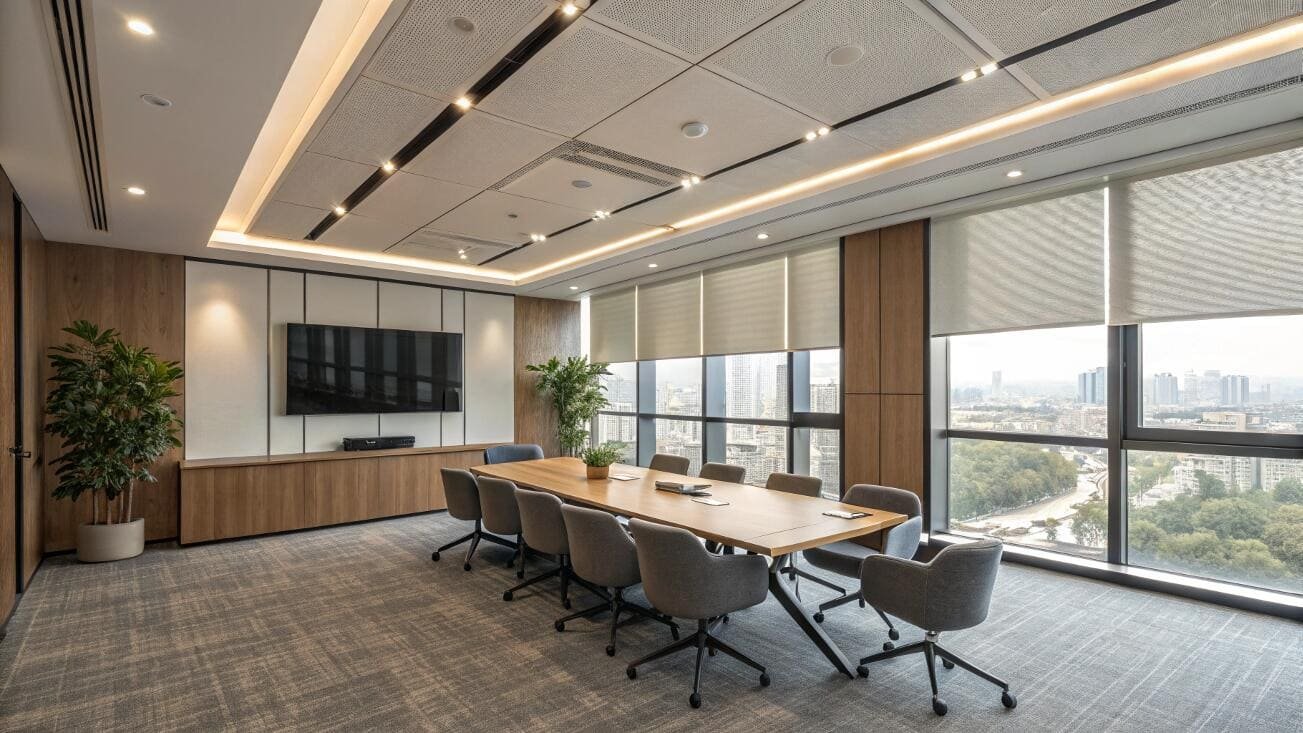
As a supplier for large-scale commercial projects, I’ve seen countless contractors and designers grapple with this exact challenge. The need for natural light to boost productivity often conflicts with the requirement for absolute privacy for meetings or after-hours security. A simple roller blind offers a binary choice: open or closed. Dual blind systems break this limitation. They provide a layered, adaptable solution that meets the diverse demands of a modern workspace throughout the day, simplifying specifications and elevating the final design.
What Are the Main Types of Dual Blind Systems?
Confused by the terms "dual roller," "duo shade," and "zebra blind"? The industry vocabulary can be a barrier when you’re trying to select the right product for your project’s needs.
The two primary types are dual roller shades and zebra blinds. Dual rollers use two separate fabric layers on independent rollers, while zebra blinds use a single loop of fabric with alternating sheer and solid bands to achieve a similar day-and-night effect.
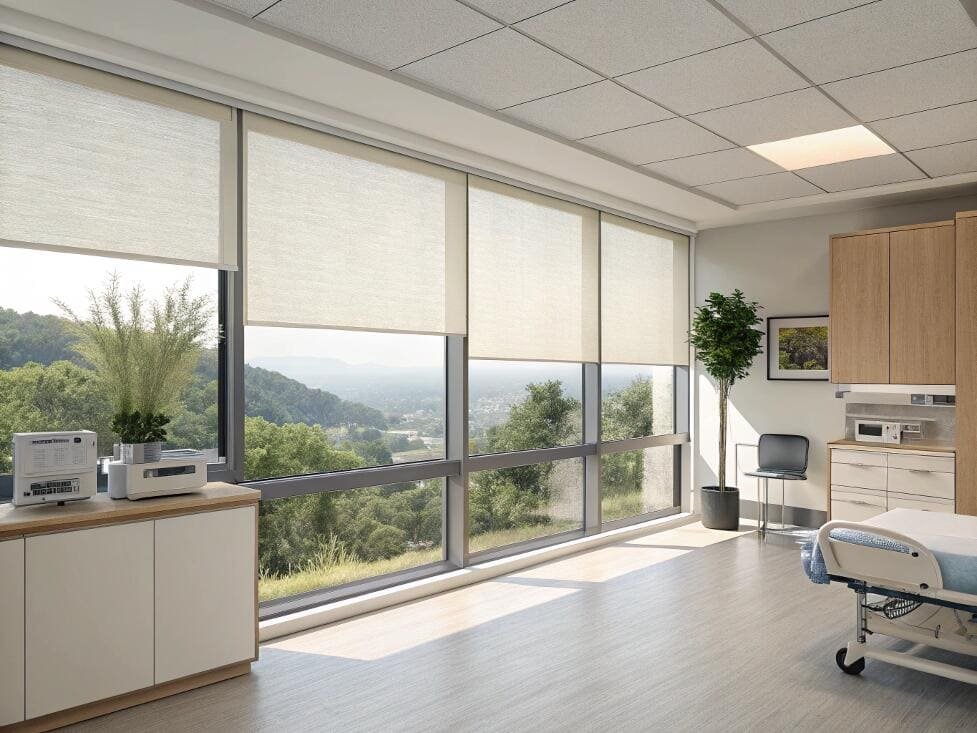
Understanding the mechanical and aesthetic differences is key to making the right choice. While both deliver on the promise of flexible light control, their application and performance profiles are distinct. I always walk my partners through these differences to ensure the specified product aligns perfectly with the room’s function, whether it’s a high-security boardroom or a collaborative open-plan office. One is about total functional separation, while the other is about nuanced, artistic light modulation.
Dual Roller vs. Zebra Blinds
- Dual Roller Shades: This is the workhorse system for performance. It consists of two full rollers housed within a single cassette. The front roller typically holds a solar screen fabric for daytime use, while the back roller holds a blackout fabric for complete privacy. They are operated independently.
- Zebra Blinds (Duo Shades): This system uses a single, continuous loop of fabric with alternating horizontal stripes of sheer and opaque material. As you adjust the blind, these stripes glide over each other, allowing you to transition from an open, sheer view to semi-private or fully-private alignment.
Here’s a breakdown I use to help designers choose:
| Feature | Dual Roller Shades | Zebra Blinds (Duo Shades) | Project Decision Point |
|---|---|---|---|
| Mechanism | Two independent rollers in one cassette. | Single fabric loop with alternating stripes. | Dual rollers offer true, separate functionality. |
| Privacy Control | Absolute (100% block with blackout layer). | Graduated (Overlapping stripes offer privacy). | For sensitive areas like labs or boardrooms, the total block of a dual roller is superior. |
| Light Control | Binary (Sheer or Blackout). | Granular (Fine-tune light by adjusting stripes). | Zebra blinds provide more artistic and subtle light filtering for general office spaces. |
| Aesthetic | Clean, functional, and minimal. | Soft, textured, and visually dynamic. | Zebra blinds make a stronger design statement. |
| Installation Footprint | Deeper cassette required (~5-7 inches). | Slimmer cassette profile (~3-4 inches). | Zebra blinds are better for shallow window reveals. |
Are Dual Blind Systems a Worthwhile Investment for Commercial Projects?
Project managers often see the price tag on dual systems and ask if they are really worth it. Is the added functionality enough to justify the budget increase over standard shades?
Yes, for any space with changing needs, a dual blind system is a smart investment. The ROI comes from combining two types of window treatments into one, saving on the hardware and labor of installing separate blinds, while massively improving user comfort and energy efficiency.
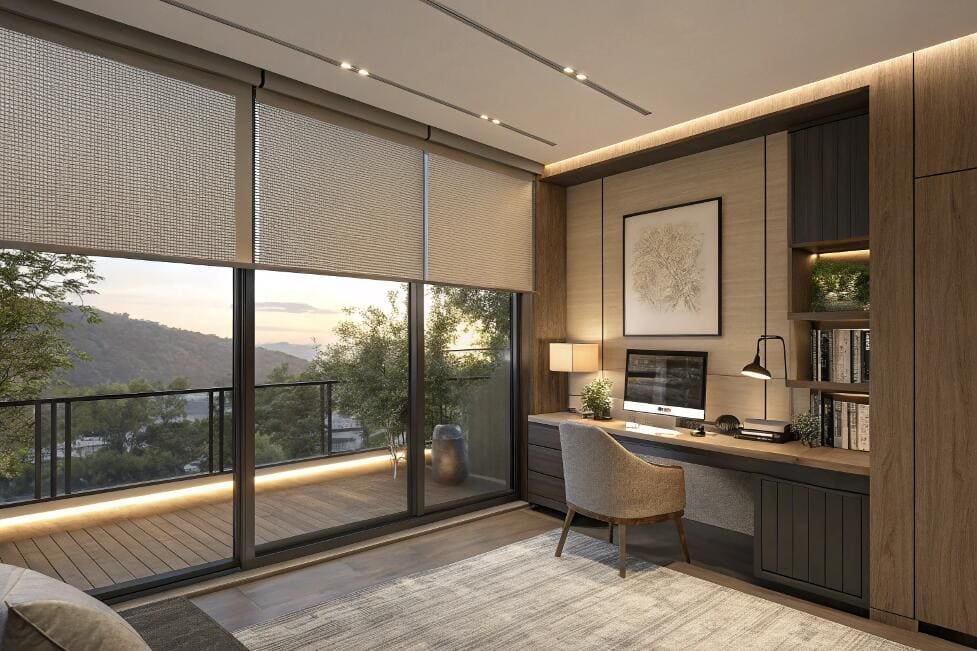
The conversation about value should never stop at the upfront cost. I always encourage clients to look at the Total Cost of Ownership[^1] (TCO). A standard solar shade is cheap, but it offers zero nighttime privacy. Adding a second blackout shade later means doubling your hardware, installation, and control costs. A dual blind system consolidates this into a single, cohesive unit from day one, delivering more value over the building’s lifecycle. The performance benefits in energy savings and employee well-being provide a clear and compelling financial case for the initial investment.
Breaking Down the Long-Term Value
- Cost-Effectiveness: While the initial outlay is higher than a single blind, it’s almost always lower than the combined cost of purchasing and installing two separate blinds (one solar screen[^2], one blackout) on the same window. You save on brackets, headrails, and labor.
- Energy Efficiency: The solar screen layer is a powerful tool for reducing energy consumption. By blocking up to 95% of UV rays and significantly reducing solar heat gain, it lowers the load on HVAC systems, especially on south and west-facing facades. This translates into measurable utility savings.
- User Productivity & Satisfaction: Glare is a major disruptor in the modern office. Dual systems eliminate glare on screens while preserving outside views, which is proven to boost employee morale and focus. The ability to easily switch to privacy mode enhances comfort and security.
Here is a simplified TCO comparison for a typical commercial window:
| Cost Factor | Standard Solution (2 Separate Blinds) | Integrated Dual Blind System | Advantage |
|---|---|---|---|
| Initial Hardware Cost | ~$350 | ~$450 | Higher initial cost for the dual system. |
| Installation Labor | ~$200 | ~$120 | Lower labor cost for the single unit. |
| Annual Energy Savings | ~$25 (Solar Shade Only) | ~$35 (Better Insulation at night) | Dual system provides added thermal barrier. |
| 5-Year TCO | ~$675 | ~$645 | Breakeven point is often within 3-4 years. |
This analysis doesn’t even factor in the superior aesthetics and functionality, which add intangible value to the property.
How Do Dual Systems Master Privacy Control Day and Night?
The "fishbowl effect" is a top concern for any ground-floor or high-visibility commercial space. At night, interior lights make an office completely transparent from the outside, posing a major privacy and security risk.
Dual systems eliminate this problem entirely. During the day, the solar screen layer provides one-way visibility. At night, you simply deploy the independent blackout layer for 100% visual blockage, ensuring complete confidentiality.
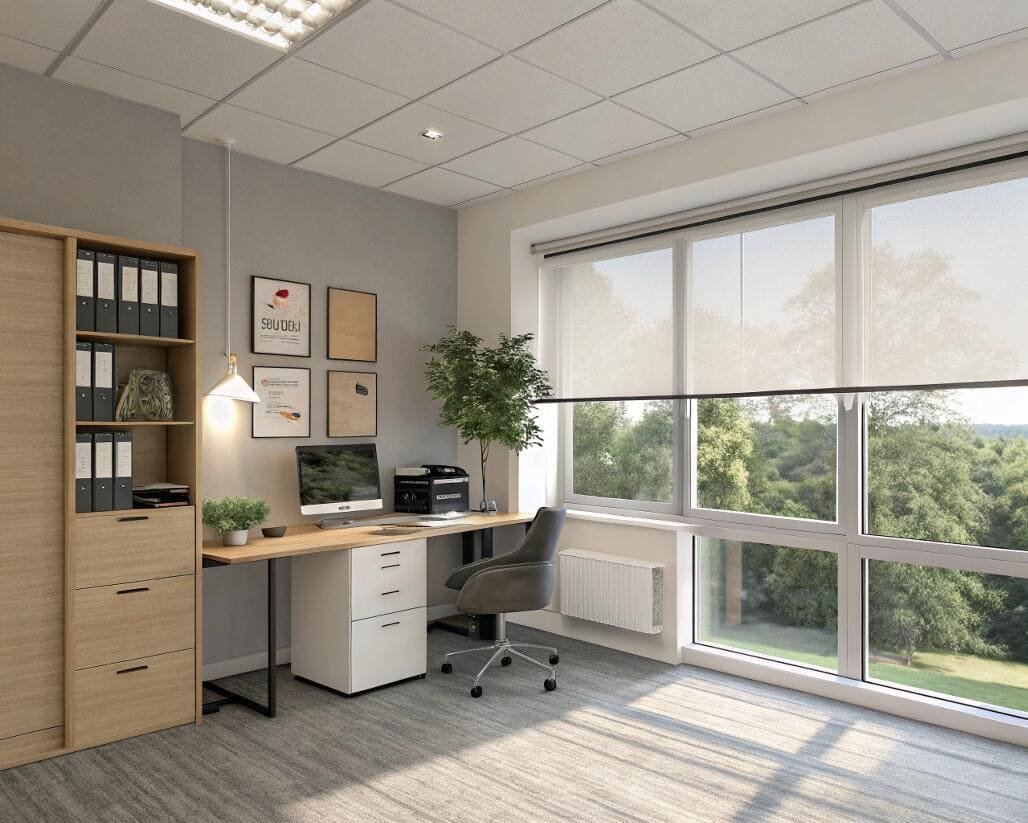
Achieving flawless privacy is a science of light management. The effectiveness of any window treatment depends on the lighting conditions. As an expert in this field, I stress to my clients that a solution must work 24/7. Dual blinds are designed specifically for this purpose. The two-fabric strategy ensures you have the right tool for every lighting scenario, from the bright glare of midday to the complete darkness required for a confidential evening meeting. Let’s look at how to configure them properly.
The Right Configuration for Every Scenario
- Daytime Mode (Exterior is Brighter): Deploy the solar screen fabric only. These fabrics have a specific "openness factor," typically 1%, 3%, or 5%. A lower number means a tighter weave. For most commercial applications, a 3-5% openness provides excellent glare control[^3] and allows clear views out, while the reflective properties of the screen make it difficult for people to see in.
- Nighttime Mode (Interior is Brighter): This is when the effect reverses. The solar screen now makes you highly visible. The solution is to deploy the second roller with the blackout fabric. This opaque layer blocks 100% of light and provides complete, guaranteed privacy.
- Maximum Privacy Environments: For areas like data centers, research labs, or legal offices, I recommend specifying dual roller systems with side channels. These U-shaped aluminum tracks are installed along the sides of the window frame, eliminating any light gaps and ensuring no line of sight is possible from any angle.
Here’s a simple guide for operation:
| Time of Day | Window Treatment Layer Deployed | Visibility Out | Visibility In (Privacy Level) |
|---|---|---|---|
| Morning/Day | Solar Screen Only | Excellent | Very Low (High Privacy) |
| Dusk/Twilight | Solar Screen + Partial Blackout | Moderate | Moderate (Privacy Decreasing) |
| Night | Blackout Layer Only | None | None (Total Privacy) |
What Are the Installation and Integration Challenges for Dual Blinds?
A dual blind system[^4] sounds perfect, but what are the practical hurdles? Project managers rightfully worry about installation requirements and ensuring compatibility with the building’s smart systems.
The main considerations are mounting depth and controls integration. Dual roller systems have a larger footprint and require careful planning with the architect. For automation, you must choose a motor system that speaks the same language as the Building Management System[^5] (BMS).
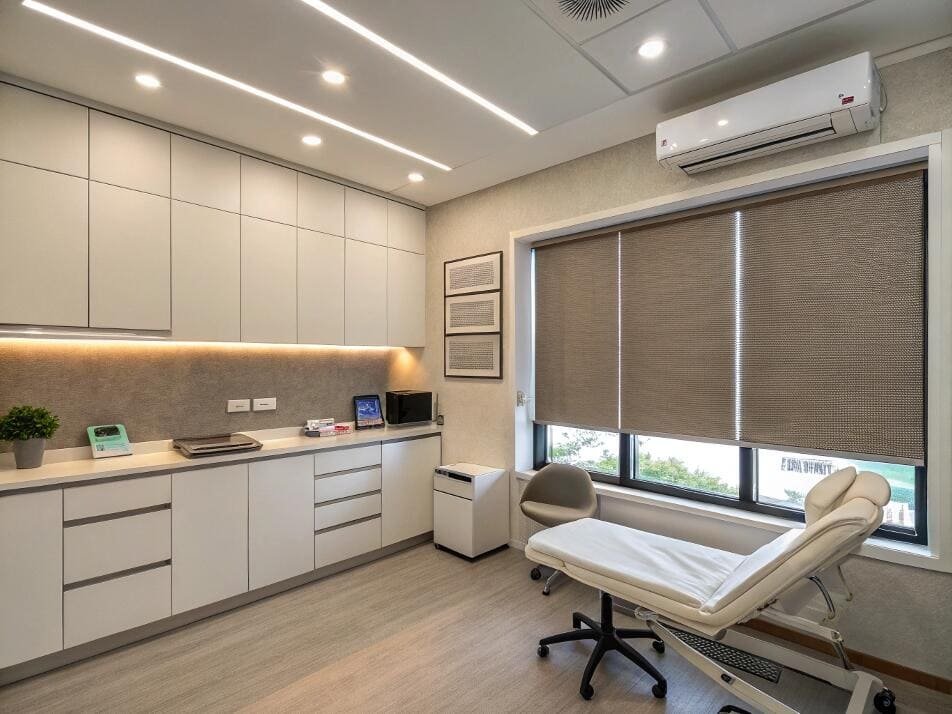
These are not obstacles, but they are critical planning points. In my experience, addressing these questions early in the design phase is the secret to a smooth installation. We provide detailed technical spec sheets and work directly with architects and integrators to ensure there are no surprises on site. A successful project is all about anticipating these needs, from ensuring there’s enough space in the window pocket to specifying the correct wiring for the automation gateway.
Technical & Space Considerations
- Mounting Depth: A dual roller blind cassette is deeper than a standard one, typically requiring 5 to 7 inches of clearance for an inside mount. If the window jamb is too shallow, you’ll need to do an outside mount on the wall or ceiling. Zebra blinds offer a slimmer profile, often fitting within 3-4 inches, making them a good alternative for tight spaces.
- Weight & Support: Dual systems are heavier. The mounting surface must be solid, and for very wide windows (over 10-12 feet), multiple support brackets are necessary to prevent sagging.
- Wiring for Automation: Motorized systems require power. You need to plan for either low-voltage wiring (e.g., 24V DC) running back to a central panel or line-voltage (120V AC) at the window head. This must be coordinated with the electrical contractor.
Integrating with Building Management Systems (BMS)
For large commercial builds, blinds should not be standalone devices. They must integrate with the central BMS (like systems using BACnet or KNX) for true smart building performance.
This integration allows for:
- Scheduled Events: Automatically lower blackout shades at 7 PM for security.
- Sun Tracking Automation: Adjust solar screens throughout the day based on the sun’s position to proactively manage heat gain.
- Scene Control: A "Meeting Mode" button in a boardroom can trigger the lights to dim and the blackout blinds to lower simultaneously.
The connection typically involves motors with a protocol like RS485 for robust, wired communication. These motors connect to a gateway which then translates the commands from the BMS. Our team provides the necessary documentation to make this handshake between our blinds and the building’s brain seamless.
Conclusion
Dual blind systems are the definitive all-in-one solution for commercial window treatments, offering a powerful combination of daytime glare control, nighttime privacy, and enhanced energy efficiency in a single, streamlined product.
Ready to Specify Your Dual Blind Solution?
Let’s ensure your project gets the performance and aesthetics it deserves. My team is ready to provide detailed technical sheets, CAD files, and a project-specific quote to help you make informed decisions.
Contact me directly with your project plans at info@velablinds.com to get started.
Extended FAQ Section
People also ask
How do you clean and maintain dual layer blinds?
Maintaining dual layer blinds is straightforward. For the solar screen layer, which is typically made of a durable PVC-coated polyester, a simple wipe-down with a damp cloth is all that’s needed to remove dust and smudges. For the blackout or fabric layer, use a vacuum with a soft brush attachment to gently lift away dust. Avoid using harsh chemicals. For zebra blinds, a regular light dusting is effective for the alternating stripes. It’s also good practice to operate the blinds every few weeks to ensure the mechanism remains in smooth working order.
Can dual roller blinds help with sound insulation?
Yes, dual roller blinds offer a noticeable level of sound dampening. The two layers of fabric, combined with the air gap trapped between them, create a barrier that helps absorb sound waves. This can reduce outside noise from traffic and soften interior acoustics by minimizing echo and reverberation in rooms with many hard surfaces. While not a substitute for dedicated acoustic panels, they contribute positively to the overall soundscape of a room. For projects where sound insulation is a primary goal, a double-cell honeycomb shade might offer slightly better performance due to its cellular structure.
What is the maximum size for dual blind systems?
The maximum size for dual blinds depends on the system type and control method. For dual roller blinds, motorized systems can typically be manufactured up to 15 feet (or about 4.5 meters) in width. The limitation is usually the weight of the fabric and the torque of the motor required to lift it smoothly. For extremely wide glass spans, multiple blinds can be coupled to operate in unison from a single motor and control. Manual, chain-operated systems are generally limited to smaller widths, around 8-10 feet, to ensure the mecha
---
[^1]: Understand the long-term financial benefits of investing in quality window treatments.
[^2]: Learn how solar screens can enhance energy efficiency and comfort in your space.
[^3]: Explore solutions to minimize glare and enhance comfort in workspaces.
[^4]: Explore this resource to understand the innovative design and functionality of dual blind systems.
[^5]: Learn about the benefits of integrating window treatments with smart building systems.Partner with VelaBlinds for Your Next Project
Smart window treatments shouldn’t be complicated. After working with 500+ distributors and contractors worldwide, I’ve streamlined the process to get you quality products, competitive pricing, and reliable support – every time.
Why project professionals choose VelaBlinds:
- ✅ Fast, Accurate Quotes – Detailed specs and pricing within 24 hours
- ✅ Transparent Pricing – No hidden fees, volume discounts clearly outlined
- ✅ Quality Assurance – Direct partnerships with certified OEM manufacturers
- ✅ Project Support – Dedicated account manager from quote to delivery
Start your next project:
📧 Quick Quote: Send your requirements to info@velablinds.com
📱 Direct Contact: WhatsApp +86 137 2012 8317
🌐 Browse Solutions: https://velablinds.com/
📁 Product Resources: Access spec sheets, catalogs & project files
Jimmy Chen, Founder
"I built VelaBlinds to solve the real challenges I faced as a project buyer – long lead times, unclear specs, and unreliable suppliers. Let’s discuss how we can power your projects with smarter blinds."
Serving distributors and contractors across North America, Europe, and Australia since 2018.

